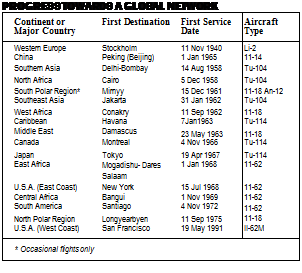World Airline Status

Slow But Steady
For several decades, Aeroflot was not its own master; indeed, under the Soviet system, it probably never was; but in later years, as the Cold War thawed, it acquired more autonomy and could influence the course of its own route expansion and aircraft development. In the international arena, almost a decade was to pass after the end of the Second World War before an Aeroflot aircraft was seen in western Europe, when an Ilyushin 11-12 resumed service to Stockholm in 1954. Subsequently, progress to other continents was slow.
Back in the 1920s, Dobrolet had made connections to Mongolia and Afghanistan, and experimental flights had been made to China. Now, in 1955, as the Soviet Union formed a close alliance with Mao’s People’s Republic, Aeroflot opened a link with Peking (Beijing); and the next year resumed flights to Kabul. More far-reaching tentacles reached out, with Tupolev Tu-104 service to India in 1958, to Jakarta in 1962, and Tupolev Tu-114 service to Japan in 1967. Vietnam
|
|
came on stream in 1970.
Next continent was Africa, with an Ilyushin 11-18 service to Cairo in 1958; then to West Africa, to Guinea, in 1962. During the period of the rise of African nationalism and the collapse of colonialism, the Soviet Union was anxious to capitalize (if that is the right word) on the situation; and Aeroflot was often the emissary, opening up links with Moscow throughout the 1970s and 1980s.
To The New World
These routes in the Eastern Hemisphere had been undertaken mainly with the Tupolev Tu-104 and the Ilyushin 11-18. Not until the introduction of the big turboprop Tu-114 in 1961 did Aeroflot feel confident enough, and the Soviet Union feel proud enough, to span the Atlantic. Service to Havana started in 1963 and to Canada in 1966. When the Ilyushin 11-62 was ready, Aeroflot was able to claim some slots at New York’s Kennedy International Airport.
And just as it had made its first landfall in North America in Fidel Castro’s Cuba, so it repeated the pattern by opening the first service to South America when Chile voted in a Marxist government, and Aeroflot promptly began to fly to Santiago, via Gander and Havana, in 1972. Eleven years later it started service to Buenos Aires; and later on to Nicaragua, where the left-wing Sandanistas had ousted the Somosas.
Political Ups and Downs
While in most parts of the world, politics did not interfere with, although they sometimes helped, sometimes hindered, Aeroflot’s ambitions to forge a global network. The relationship with the United States was so precariously balanced that the smooth continuance of scheduled air service between New York (and Washington, from 5 April 1974) and Moscow was never assured. In December 1981, all pretense of tolerance was thrown aside when martial law was declared in Poland, and one of the knee-jerk reactions of the Reagan administration was to terminate Aeroflot’s service to the U. S.A. Less than two years later, on 15 September, even the Aeroflot offices in the U. S. were closed down after a Korean airliner had been shot down by Soviet jets off the coast of Kamchatka.
Other countries had also imposed a ban after the ‘Flight 007’ incident, but in time the political climate eased and Aeroflot continued to build its route system. Not until 29 April 1986, however, was Aeroflot able to resume service to the States, after Presidents Reagan and Gorbachev had met in Geneva in the fall of the previous year. By 7 December 1987,
when Mikhail made a state visit to Washington, the Ilyushin I1-62M was not even remarked upon by the press. Aeroflot was part of the scene.
Polar Specialist
Not all of Aeroflot’s routes and services were politically motivated or necessarily linked with political strategy. The same could be said for the airlines of other nations, although it is arguable that Aeroflot was, as a branch of the Soviet Civil Air Administration, more directly the instrument of policy than were some other flag carriers or ‘chosen instruments’. The pioneering of some routes, however, while having certain political undertones, were just as much examples of the true spirit of airline enterprise and development.
On 10 September 1975, for example, Aeroflot opened a twice-monthly service to Longyearbyen, in Spitzbergen (Svalbard), a Norwegian territory of the Arctic on which there were two Soviet-operated coal mines. Questions were occasionally raised as to why the U. S.S. R., with all its extensive wealth of coal within its own borders, should need a couple of mines in Spitzbergen. Such suspicions aside, it did give Aeroflot, along with S. A.S., the privilege of operating to the most northerly airport in the world open to the public.
At the other end of the globe, on the opposite polar axis, Aeroflot was also active, having made its first flight to Antarctica as early as 1961 (see pages 70-71). The Soviet national air carrier thus carried the flag to every continent except Australia, and operated both to the Arctic and the Antarctic — though service to Mirnyy and Molodezhnaya was not exactly frequent, roughly once or twice a year.
Round-The-World
Aeroflot was eventually to join the ranks of those airlines that offered service completely around the world — or nearly enough to qualify for that claim. On 19 May 1991, from its well-established far eastern terminal of Khabarovsk, an Ilyushin I1-62M started service to San Francisco, via Anchorage. On 29 March 1992, this route was augmented by a direct flight, also via Anchorage, from Moscow.
Pan American Airways used to be proud of its round-the – world flights but Juan Trippe and his successors never did fill the domestic gap across the U. S.A. until it purchased National Airlines in 1978. The supreme irony was that, at the end of the same year when Aeroflot achieved round-the-world status, Pan American Airways, one of the world’s great airlines, closed its offices and terminated all its services.











